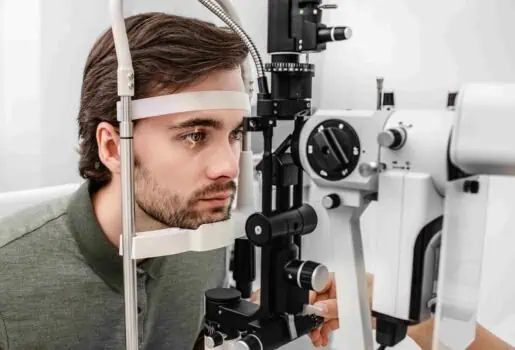When you think about workplace wellbeing, eye health doesn’t always get the attention it deserves. Most jobs today involve staring at screens, working under artificial lighting or handling tasks that demand sharp vision. This constant strain can cause discomfort, but it also leads to reduced productivity, more errors and long-term health concerns. This is why proactive vision screening should be a priority for every employer.
The Hidden Impact of Poor Eye Health at Work
You might not notice the early signs of strain right away. Headaches, blurred vision, or trouble focusing often appear gradually. These symptoms may seem minor at first, yet they quickly undermine performance. A recent UK and Ireland study found that around 63% of people who use digital devices for work experience digital eye strain (DES). Poor vision health reduces concentration, leads to fatigue, lowers accuracy, and raises the risk of mistakes.
In roles that demand precision, such as manufacturing, healthcare, or logistics, even a slight dip in vision can have serious consequences. If employees cannot see clearly, their safety and the safety of others may be at risk. Left untreated, small vision problems can develop into conditions that require more complex treatment. This results in higher costs for both the employee and the employer.
Why Proactive Screening is More Than a Legal Obligation
The Health and Safety (Display Screen Equipment) Regulations 1992 require employers to provide and pay for eye examinations when regular screen users request them. While this satisfies legal requirements, it often means responding only after symptoms have already affected performance or wellbeing.
Companies specialising in innovative medical screening devices are helping shift the focus toward early detection in the workplace. Among the solutions available, this company provides portable integrated technology that combines optics, electronics, and computing to perform quick and reliable visual acuity tests. The system is designed to identify common visual disorders before they become disruptive, allowing employers to take timely action.
By adopting proactive screening methods, organizations meet compliance standards and show a genuine commitment to employee health. This approach helps reduce absenteeism, lower treatment costs, and build a more resilient workforce.
Boosting Productivity and Reducing Errors
Sharp vision plays a direct role in productivity. When staff can see clearly, they stay focused, accurate, and efficient. Regular screenings help cut down mistakes across roles, such as factory workers reading measurements or office employees analysing data.
The link between good eye care and fewer errors is simple. A worker who’s not squinting at a Snellen eye chart or battling headaches will naturally perform better. Timely vision correction also allows employees to maintain concentration and accuracy.
Clear near and far vision is especially important for staff who move between tasks, like checking machinery across a shop floor after reading close-up documents. Even small investments in proactive checks can lead to measurable gains in output.
Eye Health and Workplace Safety
Workplace safety depends heavily on vision. In sectors like construction, transport and healthcare, poor eyesight can create dangerous situations. A lorry driver with undiagnosed issues may misjudge distances. A nurse with reduced near vision may find it harder to read medication labels accurately. Even in office settings, employees with untreated problems are more likely to experience accidents or develop posture-related concerns from straining to see.
Screenings can also detect risks such as colour blindness, reduced peripheral vision or early signs of systemic diseases like high blood pressure or diabetic retinopathy. These conditions, if left untreated, increase the chance of vision loss, long-term visual impairment, or conditions like age-related macular degeneration. By putting regular programmes in place, you lower these risks and create a safer environment for everyone.
Supporting Employee Wellbeing and Retention
Wellbeing is not only about gym memberships or mental health programmes. Vision plays a vital part in how comfortable and confident people feel at work. By providing access to an eye care professional or trusted eye doctor, you show employees that their wellbeing matters. This has a direct impact on morale.
When staff feel supported, they’re more likely to stay. High retention reduces the cost of recruitment and training while building loyalty. In a competitive job market, benefits like proactive vision screening programs set you apart as an employer of choice. Staff want to know they’re working in a place that invests in their long-term health.
Practical Steps for Employers
Getting started need not be difficult. Here are a few practical steps you can take:

- Partner with local opticians: Many offer workplace packages for regular checks. These can refer staff for a comprehensive eye exam or specialist tests, such as a retinal exam, if screening shows potential risks.
- Use mobile screening services: These bring the equipment directly to your site, making it simple for staff to take part.
- Raise awareness: Share information on screenings during wellbeing initiatives or safety briefings.
- Encourage uptake: Make it voluntary but strongly encouraged, and assure staff that it’s confidential.
You should also consider scheduling screenings annually or every two years, depending on the type of work your team does. The key is consistency.
Final Thoughts
The benefits of proactive screening reach far beyond the clinic. It reduces strain, boosts focus and lowers the risk of accidents or long-term vision loss. Most importantly, it reassures employees that their health matters. By making screenings routine, you create a culture where prevention is valued, safety is protected and everyone has the clarity they need to perform at their best.

